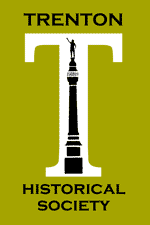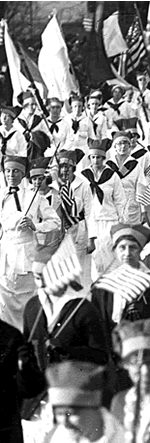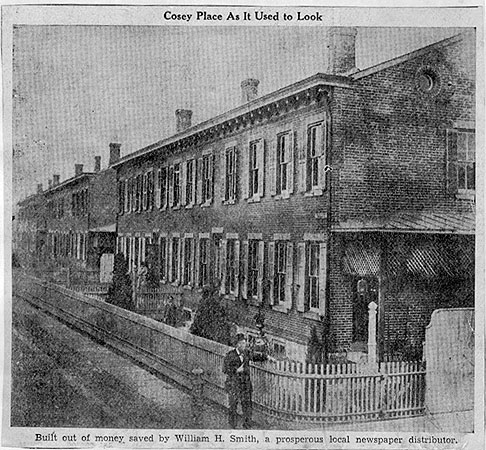



TRENTON IN BYGONE DAYS
By
John J. Cleary
Sunday Times Advertiser, August
25, 1935
Since
mention was made a few Sundays ago of Cosey Place, in the Third Ward, I
have been fortunate enough to secure a good photograph of this little residential
section through the courtesy of Dr. W. Henley Smith, grandson of William
H. Smith. As already told, Cosey
Place was designed by Smith, Sr., one of the two distributing agents of
the True American long ago. He prospered
and invested his savings in the tract of land, then vacant, which ran along
the west side of Cooper Street from Market to the property of John Dunphy
near Centre Street. Mr Smith sold
a number of building lots for home-seekers and built several houses which
he disposed of as the years went on. He
made his own home on No. 15 Cooper Street, at the corner of Smith's Avenue,
a narrow artery which he himself created, opposite the rear of the Sacred
Heart Church. It runs from Cooper to Lamberton Street. The late Joseph S. Thorn, the cracker baker,
lived in No. 11, the other one of a pair of handsome brick dwellings. Among other neighbors on Cooper Street who
gradually built up the extensive vacant tract were Sheriff Benjamin F. Walton,
George Cotton, the family of Dr. Gihon, Jeremiah J. Kelly, Harrison F. English,
father of the present engineer of streets, Joseph E. English, the Margerums,
Anglums, McCaffreys, Rogers and others.
The
accompanying picture shows Cosey Place as it looked soon after its erection
in 1880. It was a rather pretty
little colony of ten homes with grass plots in front facing eastwardly,
neatly fenced in and with sidewalks paved.
Mr.
Smith, the builder, is seen in the picture his arm resting on the picket
fence. Oscar, his son, now deceased,
stood in the first yard. Another
son, Frank H., now a local newsdealer, stands in yard No. 2, accompanied
by his little son, Ernest King Smith. This
boy was called for Ernest King, then local editor of the True American. Cosey Place has depreciated greatly in the
intervening years, but it supplies an example of what an enterprising landlord
could do to improve a piece of land not fronting on any of the streets of
the city.
William
H. Smith, by the way, was born in Egypt while his father was in the service
of the British Government in that part of the world. He came to this country while still an infant.

--------------------
Changes
and alterations seem to be the life of a growing city and Trenton has witnessed
a generous measure of these mutations.
Nowhere is there a more striking evidence of the fact than in the
story of Petty's Run. Many a Trentonian
would be puzzled to describe the course of what is now an insignificant
stream. Indeed it has pretty nearly disappeared from
view, having been walled in and arched over like a drain, but it is still
there flowing beneath some of our most prominent streets and important public
buildings.
I
had a chat a few days with John D. Faussett, law librarian at the State
Library, about this pseudo-historic waterway, and he gave me his recollections
as a boy when the run was open to the vision of all passersby. Mr. Faussett's younger days were spent on North
Warren Street, opposite Bank, and he was therefore in a position to note
Petty Run's tortuous course. He
recalls among other things which most old Trentonians have forgotten, that
at one time it supplied power for a number of local industries.
Starting
at the north John Haws, well-known coffee and spice manufacturer of other
days, operated his plant on Willow Street above Belvidere Railroad by means
of a wheel that drew power from Petty’s Run.
The run then passed under the canal-feeder and appeared next, harnessed
for power purposes, about where St. Mary’s High School is located. In this case it served Cowell’s turning shop.
Passing
across Bank Street and Chancery Lane, the little stream was utilized by
Henry Potts for his tannery, and thence it made its way across Tanyard Alley
(now West Hanover Street) and under Willow Street and southward to State
Street, finally reaching Armstrong’s paper mill on Wesr Front Street which
also relied on the run for much of its power.
It then ran a course to Craft’s bow factory located below Front Street
and finally made a turn into the Assunpink Creek.
Mr.
Faussett’s recollection does not exhaust the list of industries which sooner
or later drew on Petty’s Run for power, but gives an idea of the considerable
part that this little stream. (probably larger in remote times), had in
the operation of local mills and factories.
It has been said on good authority that the run furnished power to
operate one of the local newspaper presses for periods of time before the
Civil War but that failing occasionally in dry spells, hand power had to
be resorted to. The newspaper press
was located in a printing shop on West State Street.
--------------------
Apropos
of some recent comments about the disappearance of various old hostelries
in the centre of town, I had a conversation last week with the Rev. Henry
Armstrong, of Long Island, who has an interesting recollection of the National
Hotel on Hanover Street. At the
time which was in the 80’s, he resided in this house with his father, Colonel
Samuel Armstrong, of the Quartermaster-General’s office, and with his mother
and his baby sister, Katherine. The
National was a favorite stopping place with show people temporarily in town
and ‘Buffalo Bill’ Cody was a guest on a number of occasions. The large stableyard in the reaer of the hotel was useful for Cody’s
Wild West cowboys, his live stock and wagons including the famous “Deadwood
Coach.”
Dr.
Armstrong still remembers with a bit of thrill that one evening before the
light were turned on in the hotel, he was on his way through an upstairs
corridor to the apartments occupied by his family, when suddenly he was
confronted by a tall Indian in war dress and to an imaginative boy it looked
like there was trouble ahead. He
let out a yell which startled his family and Colonel Armstrong came running
out into the hall with little Katherine in his arms. The child naturally was terified by the sight and uttered piercing
cries. The records do not say but
there is a suspicion that the noble Red Man’s iron nerve forsook him and
that he sought safety in flight. It
was all over in a minute or two but the incident left a lasting impression
on everyone concerned.
Among other childhood memories, Dr. Armstrong recalls the presence at the hotel of a small troupe of salespeople engaged in selling “wizard oil.” They had a tally-ho coach, drawn by four prancing horses, which was driven from the hotel yard every evening with a flourish of trumpets. A stand was made at various corners through the city and an alleged “doctor” with lusty lungs cried out the virtues of patent medicine.
The
National Hotel was operated at different times by different landlords, but
at the period herewith alluded to, the Johnstons were in control – three
or four popular young men with their mother who came here from New Brunswick.
--------------------
Stories
of the old hotels being in order, there is one told of the “United States”
that is worth repeating. Nowadays
there is no more abstemious set of tradesmen than the local printers but
in the long ago it was different. The
United States hotel in the basement beneath the bar, had an oyster saloon
which was well patronized. One evening
among the patrons was a typo of the tourist class who occupied a small table
and ordered a bowl of oyster soup. Over
the appetizing dish the printer fell asleep, having previously indulged
rather generously at the bar. Turning
the restaurant into a lodging house was “agin the rules” and before a great
while he was aroused by a waiter and told to move out.
“Bring
me an oyster stew!” was his rejoinder and the order was filled promptly.
The
next time the waiter came around, the oysters had vanished and the drowsy
chap leaned over the table asleep.
“Wake
up” was the waiter’s command, “and get a move on.”
“Bring
me a stew of oysters!” was the only response.
The
oysters came and were consumed, the fellow then dozing away.
Once
more the waiter followed the rules of the house and the customer was about
to be ejected, but again he ordered another dish of bivalves. As a matter of fact, four orders were given
in rapid succession and dispatched. The
story doesn’t go any farther, but it may be presumed that by this time the
typo had sobered up on oysters and was able either to sit up straight or
to march out into the open. The
Trent Theatre subsequently was built on the site of the old hotel.
Up To Top /
Home
The Society : About Us / Artifacts
Committee / Education Committee / Preservation
Committee / Membership / Contact
Us / Events
Our History : Sights & Sounds
/ 1929 History / Old
& New / Hill Diaries / Chronological
Indexes / Trenton Made / Documents / Tours
Your Ancestors : Research Services
/ Obituaries / City
Directories / High School Yearbooks /
Cemeteries / Genealogy
The City : Buildings /
Historic Districts / North
Ward Survey / Street Names / Local
Links
Search Our Site
Up
To Top / Home
The Society : Preservation
Committee / Artifacts Committee / Membership / Contact
Us / Events
Our History : Sights & Sounds / 1929
History / Old & New / Hill Diaries/ Chronological
Indexes / Trenton Made
Your Ancestors : Research Services / Obituaries / City
Directories / High School Yearbooks / Cemeteries
The City : Historic Districts / North
Ward Survey / Street Names / Local Links